Can You Wash a Bamboo Pillow
Yes, you can wash a bamboo pillow, but you'll need to handle its components separately. The bamboo cover should be removed and machine washed on a gentle cycle with lukewarm water and mild detergent, while avoiding fabric softeners and bleach. For the memory foam filling, stick to spot cleaning with a damp cloth, as machine washing can damage its structure. Air dry both parts in a well-ventilated area away from direct sunlight, and make sure they're completely dry before reassembling. Proper washing technique is essential for maintaining your pillow's comfort, support, and hypoallergenic properties – there's much more to learn about extending your bamboo pillow's lifespan.
This post may contain affiliate links. If you make a purchase through these links, I may earn a commission at no additional cost to you. Additionally, portions of this post may be generated using artificial intelligence (AI) technology. While we strive for accuracy, please be aware that AI-generated content may not always be perfect and should be fact-checked when necessary.
The Spatula Scoops
- Yes, bamboo pillows can be washed, but the cover and memory foam filling must be cleaned separately using different methods.
- The bamboo cover is machine washable using lukewarm water, mild detergent, and a gentle cycle without fabric softeners.
- Memory foam filling should only be spot cleaned or hand washed, avoiding machine washing to prevent damage.
- Air dry both components in a well-ventilated area away from direct sunlight, never use a machine dryer.
- Regular washing every 3-4 months maintains hygiene, but improper cleaning methods can damage the pillow's materials and structure.
What Are Bamboo Pillows
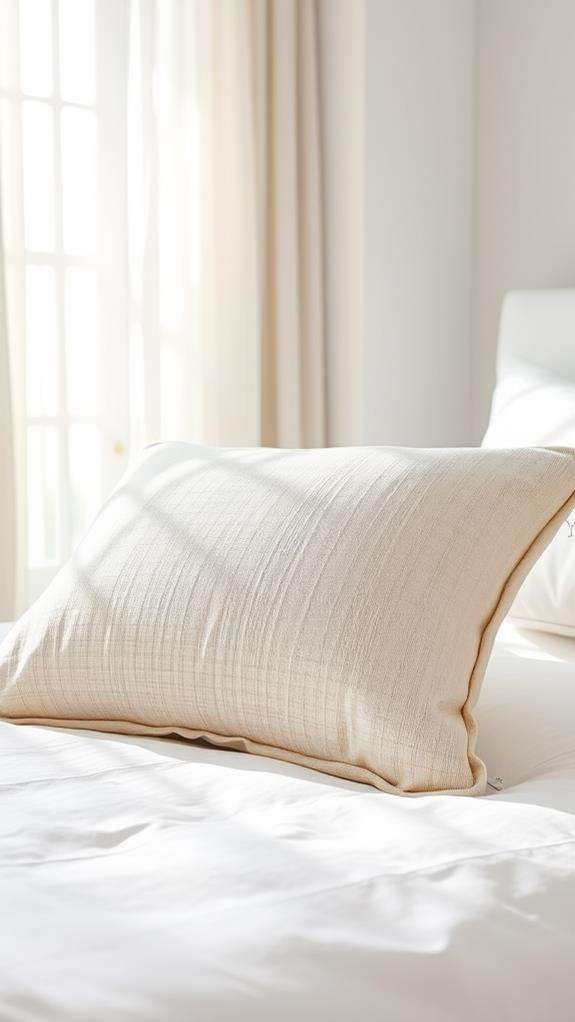
Three key components make up a bamboo pillow: a bamboo-derived outer cover, shredded memory foam filling, and specialized construction that promotes airflow. When you're looking for a pillow that combines comfort with functionality, you'll find that bamboo pillows offer an impressive blend of both features.
The outer cover, which you'll appreciate for its softness, is crafted from bamboo fibers that naturally resist allergens and dust mites. You'll notice that this removable cover makes maintenance straightforward, as you can easily unzip it for washing. Inside, you'll find shredded memory foam that adapts to your unique sleeping position, whether you're a side, back, or stomach sleeper.
What sets these pillows apart is their innovative design that promotes better airflow throughout the night. You'll experience the cooling properties of bamboo fibers working in harmony with the breathable memory foam structure. If you're sensitive to allergens or often wake up feeling too warm, you'll benefit from the hypoallergenic properties and temperature-regulating features that bamboo pillows provide, making them an excellent choice for year-round comfort.
Benefits of Regular Pillow Washing
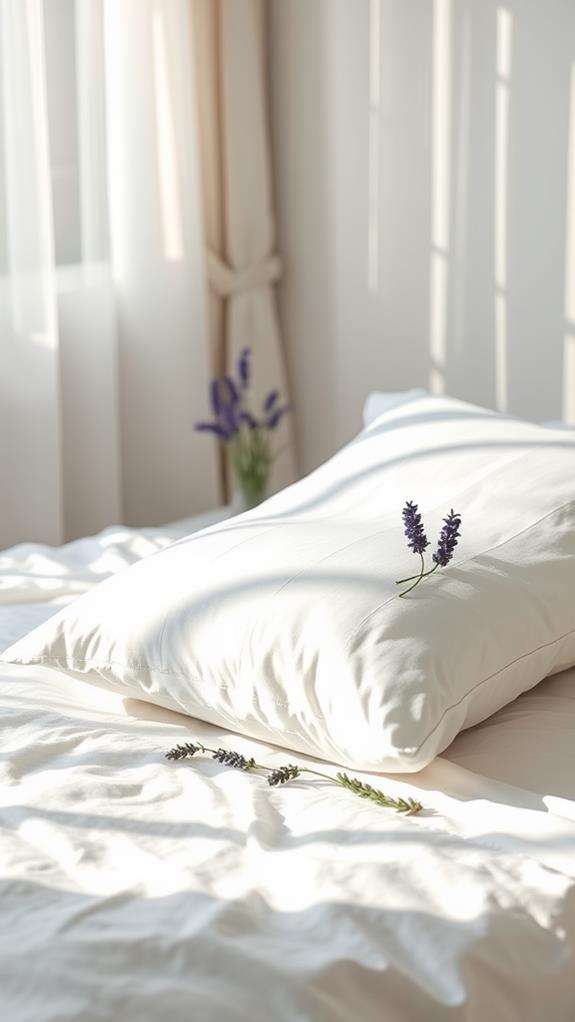
While you might not think about it often, regularly washing your bamboo pillow delivers notable health and comfort benefits. When you maintain proper hygiene through consistent cleaning every 2-3 months, you're creating an ideal sleep environment that protects your well-being and extends your pillow's lifespan. Just as using high-quality ingredients like 4th & Heart Grass-Fed Ghee can enhance your meals, maintaining your pillow contributes to a healthier sleep experience.
The benefits of regular washing are extensive and directly impact your daily life:
- Eliminates allergens, dust mites, and bacteria that can trigger allergic reactions
- Removes accumulated sweat and oils that may cause unpleasant odors
- Restores the pillow's fluffiness and support capabilities
- Prevents the buildup of stains that could permanently damage your pillow
- Maintains the bamboo fabric's natural antimicrobial properties
Your commitment to regular washing doesn't just improve your pillow's appearance; it greatly enhances your sleep quality and overall health. The process helps maintain the structural integrity of the shredded memory foam inside, ensuring you continue to receive proper neck and head support. By incorporating regular cleaning into your household maintenance routine, you're investing in both your pillow's longevity and your personal well-being, making it an essential practice for any bamboo pillow owner.
Preparing Your Bamboo Pillow
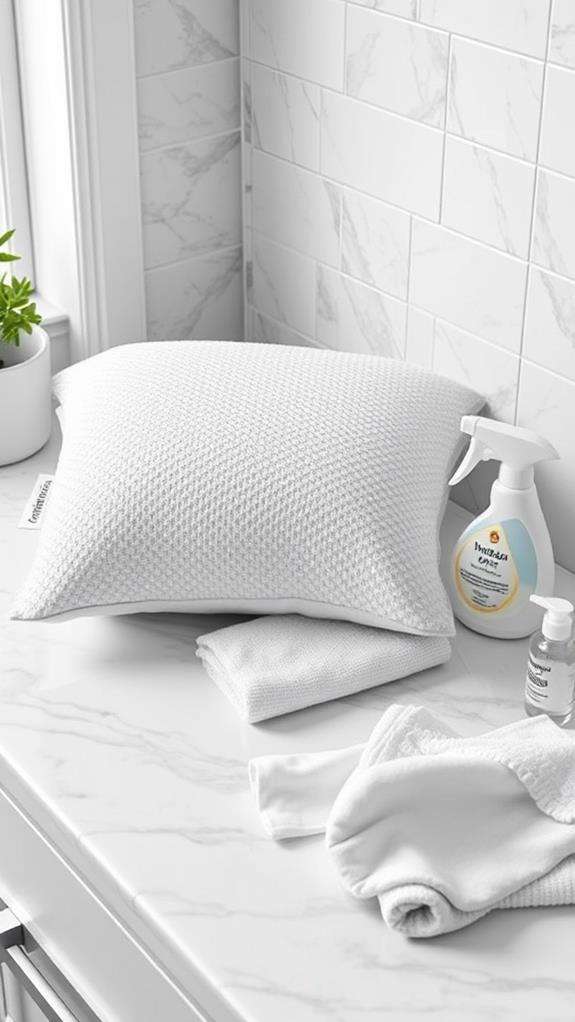
Proper preparation up front makes washing your bamboo pillow considerably easier and more effective. Before you begin the cleaning process, you'll need to carefully review the manufacturer's washing instructions that came with your pillow, as these guidelines are specifically tailored to your product's unique construction and materials.
Start by removing the bamboo cover from your pillow, as you'll need to wash these components separately. The memory foam interior requires special care and shouldn't go in your washing machine. Before proceeding with the wash, inspect the cover thoroughly for any spots or stains that might need pre-treatment. You'll want to address these areas before the main wash to guarantee the best possible results.
Get your washing supplies ready, making sure you have mild detergent on hand for the cover. Set your washing machine to use lukewarm water and select the gentle cycle setting. While you're preparing everything, identify a well-ventilated space where you can later air dry both the cover and pillow, keeping in mind that you'll need to avoid direct sunlight during the drying process.
Washing The Bamboo Cover
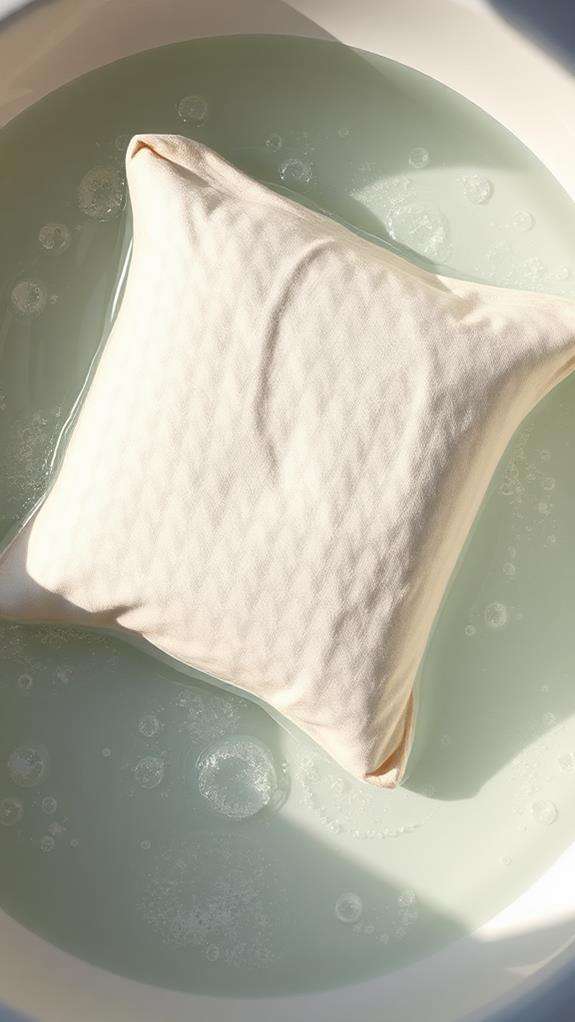
The bamboo cover requires separate washing from the memory foam interior to maintain its unique properties. When washing the pillow cover, you'll need to follow specific care instructions to guarantee its longevity and preserve its natural benefits. Start by checking your pillow's care label, as different manufacturers may have varying recommendations.
For the most effective cleaning process, follow these essential steps:
- Use lukewarm water and set your machine to a gentle cycle
- Add one tablespoon of mild detergent per regular load
- Wash the cover separately from rough materials
- Avoid using fabric softeners or bleach
- Air dry the cover completely before reassembling
During the washing process, it's vital to handle your bamboo cover with care. While you might be tempted to toss it in with your regular laundry, washing the pillow cover separately helps prevent snags and tears that could compromise its integrity. Remember to zip or button the cover closed before placing it in the washing machine, which will help maintain its shape during the cycle. Once clean, reshape the cover while damp and hang it to dry naturally, avoiding direct sunlight that could fade or damage the fabric.
Cleaning Memory Foam Filling
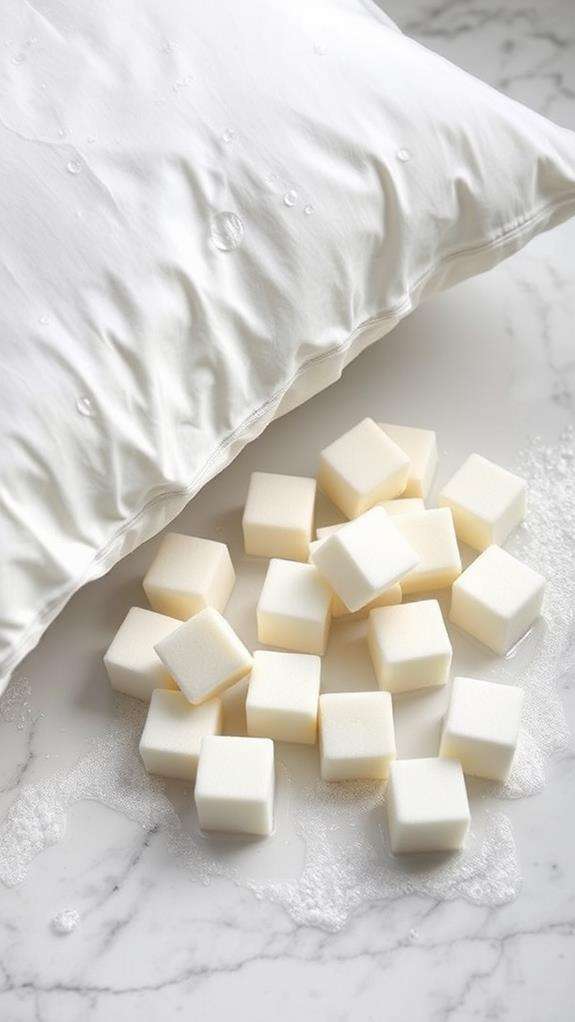
Since memory foam requires special handling, cleaning the filling of your bamboo pillow demands a gentler approach than washing the cover. You'll need to avoid machine washing the memory foam filling at all costs, as this can destroy its structure and comfort-giving properties.
For routine maintenance of your bamboo pillow's filling, you'll want to stick to spot cleaning with a mild detergent and damp cloth. When you encounter stubborn stains or odors that won't budge with spot cleaning, you can perform a careful hand wash. Simply submerge the foam in lukewarm water (no hotter than 30-40°C) with a gentle soap for up to fifteen minutes. Don't forget to rinse thoroughly with clean, warm water to remove all soap residue.
When it comes to drying your memory foam filling, patience is key. Never wring or twist the foam, as this can damage its internal structure. Instead, place it in a well-ventilated area away from direct sunlight and heat sources. While it might take longer to dry naturally, this method will help preserve your pillow's quality and extend its lifespan.
Proper Drying Methods
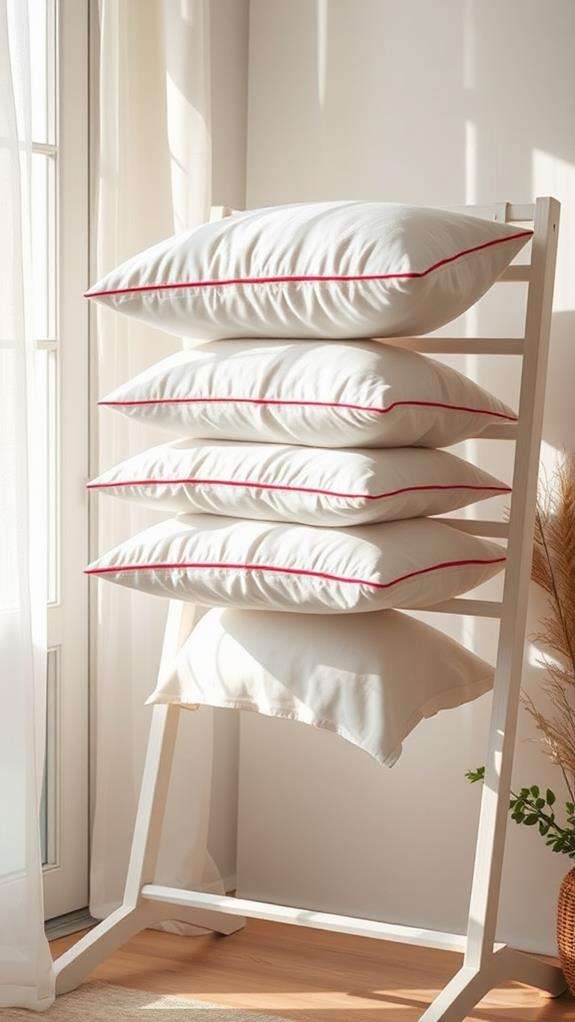
When drying your bamboo pillow, you'll find air drying is your safest and most effective option, as it helps preserve both the bamboo cover and memory foam filling. To guarantee proper drying, place your pillow on a flat surface in a well-ventilated area away from direct sunlight, and remember to flip it occasionally for even drying. Throughout the drying process, you'll want to check for remaining moisture by gently squeezing different sections of the pillow, ensuring it's completely dry before returning it to your bed.
Air Drying Best Practices
Proper air drying is essential for maintaining your bamboo pillow's quality and longevity. When you're ready to dry your pillow, choose a well-ventilated space where air can circulate freely around all sides. You'll want to avoid excessive heat, as it can damage the memory foam filling and compromise the pillow's supportive properties.
To guarantee the best results during the drying process, follow these key practices:
- Lay your pillow flat on a clean, dry surface to maintain its shape
- Position the pillow away from direct heat sources to prevent damage to the foam
- Flip your pillow every few hours when drying in sunlight to ensure even drying
- Squeeze different sections periodically to check for remaining moisture
- Allow 24-48 hours for complete drying, depending on humidity levels
Avoid Direct Heat Methods
Direct heat can spell disaster for your bamboo pillow, potentially destroying both its memory foam core and bamboo fiber cover. When drying your pillow, you'll want to completely avoid direct heat methods, including machine dryers, heating vents, and prolonged sun exposure, as these can compromise the structural integrity of your pillow's materials.
Instead, focus on air drying your bamboo pillow in a well-ventilated space. You'll get the best results by laying it flat on a drying rack, which allows air to circulate freely around all sides of the pillow. While the drying process might take longer than machine drying, it's essential for preserving your pillow's quality and extending its lifespan. Throughout the drying process, you should check for remaining moisture by gently squeezing different areas of the pillow. If you're drying the pillow indoors, position it near a fan or open window to promote airflow, but keep it away from heating vents. Remember, patience is key when drying bamboo pillows – rushing the process with artificial heat will only lead to damaged filling and deteriorated fabric.
Testing Moisture Content
Once your bamboo pillow has been air-dried, you'll need to verify it's completely moisture-free before use. The testing moisture content process is essential to prevent mold and mildew growth, which can compromise both your pillow's longevity and your health. To check if your pillow is thoroughly dry, gently squeeze different sections, paying attention to how they feel against your skin.
During the drying process, you'll want to monitor your bamboo pillow's moisture levels regularly, especially in humid conditions. Here are vital steps to guarantee proper drying:
- Perform periodic moisture checks by gently squeezing the pillow
- Look for any cool or damp spots that indicate remaining moisture
- Allow at least 24 hours of drying time in a well-ventilated area
- Flip the pillow occasionally to promote even drying
- Use a fan or dehumidifier to accelerate moisture removal
If you detect any dampness or coolness during testing, continue the drying process. Remember, bamboo pillows require complete dryness before use, so don't rush this step. Position your pillow in an area with good air circulation, and keep testing until you're confident it's thoroughly dry.
Common Washing Mistakes
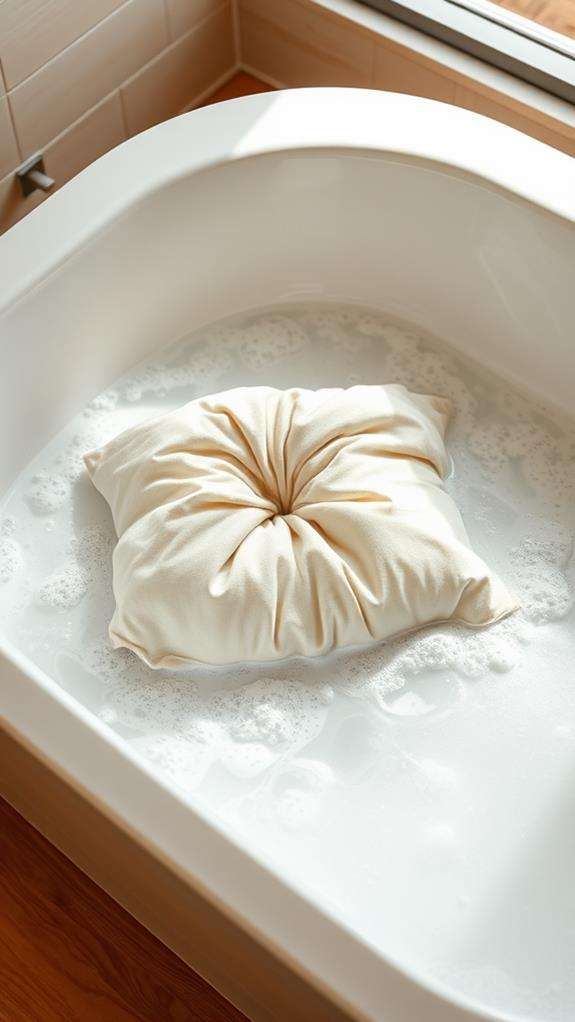
When washing your bamboo pillow, several common mistakes can greatly reduce its lifespan and comfort. You'll want to avoid using hot water, as it damages the delicate bamboo fibers, and instead opt for lukewarm or cool water with a mild detergent. Never use harsh chemicals or bleach, which can break down both the fabric and filling materials.
| Don't Do This | Do This Instead |
|---|---|
| Hot water wash | Lukewarm/cool water |
| Harsh detergents | Mild, gentle cleaners |
| Machine dryer | Air dry naturally |
| Overloaded machine | Wash separately |
Before you machine wash your bamboo pillow, always check the care label for specific instructions. Many people make the mistake of cramming their pillow into an already full washer, but this creates excessive friction that can damage the pillow's structure. Instead, wash it separately or with a few lightweight items. Perhaps the most important mistake to avoid is ignoring proper drying instructions. While it's tempting to toss your pillow in the dryer, especially if it contains memory foam, this can cause significant damage. Always air dry your bamboo pillow to maintain its shape and supportive properties.
Maintaining Pillow Freshness
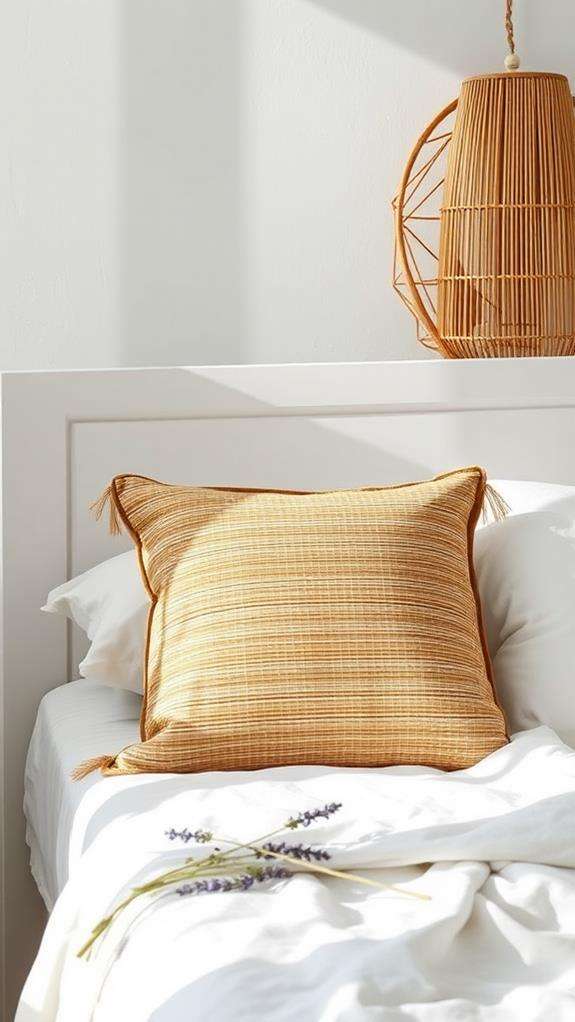
Keeping your bamboo pillow fresh requires consistent maintenance beyond regular washing. To maintain freshness and extend your pillow's lifespan, you'll need to implement several key care practices, similar to how proper food storage can enhance freshness and reduce waste, as detailed in food storage containers. When you care for your bamboo pillow properly, you're protecting your investment while ensuring a clean, comfortable sleep surface.
To help you maintain ideal freshness between washing bamboo pillows, consider these essential practices:
- Use a breathable pillow protector to create a barrier against dirt and moisture
- Air out your pillow weekly by placing it in a well-ventilated area
- Perform spot cleaning immediately when stains occur
- Dust your pillow regularly to remove dead skin cells and allergens
- Schedule regular cover washing every 2-3 months
Remember that prevention is vital when maintaining your bamboo pillow's freshness. You'll want to incorporate these practices into your regular cleaning routine. By staying proactive with maintenance, you can greatly reduce the frequency of deep cleaning needed. Don't forget to inspect your pillow regularly for signs of wear or unusual odors, as early detection of potential issues helps preserve your pillow's quality and extends its useful life.
When To Replace Your Pillow

You'll need to keep a close eye on your bamboo pillow's condition, watching for telltale signs like lumps, permanent flatness, or noticeable discoloration that signal it's time for a replacement. While bamboo pillows can last longer than traditional ones, you should plan to replace yours every 1-2 years to maintain ideal neck support and spinal alignment. If you're waking up with unexplained neck pain or allergies, or if your pillow doesn't bounce back to its original shape after being folded in half, these are clear indicators that it's time to invest in a new one.
Signs of Wear
Several telltale signs indicate it's time to replace your bamboo pillow. Through regular inspection, you'll want to watch for physical changes that suggest your pillow's performance is declining. When you notice these signs of wear, it's vital to take into account replacement to maintain peak sleep quality and hygiene.
Look out for these specific indicators that your bamboo pillow needs replacement:
- Persistent lumps or flat spots that don't reshape after fluffing
- Noticeable yellowing or stubborn stains that won't wash out
- Lingering odors that remain even after thorough cleaning
- Frayed or torn pillow covers that expose the inner filling
- Increased allergy symptoms or respiratory discomfort during sleep
You'll find that your bamboo pillow typically maintains its quality for about 2-3 years under normal use. However, if you notice any combination of these warning signs before that timeframe, don't hesitate to replace it sooner. Remember that a compromised pillow can affect both your sleep quality and health, so staying proactive about replacement is essential for maintaining proper support and hygiene throughout your rest.
When Support Diminishes
A bamboo pillow's support system naturally deteriorates over time, making replacement necessary for maintaining proper sleep posture and comfort. When you notice your pillow becoming flat or losing its shape, it's a clear indicator that the internal materials aren't providing adequate support anymore.
| Warning Signs | Action Needed | Timeline |
|---|---|---|
| Flattened Shape | Assess Support Level | Immediate |
| Neck Pain | Contemplate Replacement | Within 1 Week |
| Odors/Allergens | Deep Wash or Replace | Within 1 Month |
You'll want to pay attention to how you feel when you wake up, as persistent neck pain often signals diminished support quality. While regular washing can help maintain your pillow's hygiene, it won't restore lost structural integrity. Even with proper care, you'll need to replace your bamboo pillow every 1-3 years to guarantee ideal support for your head and neck alignment. If you've tried to wash your pillow but still notice persistent odors or allergen buildup, it's time to think about a replacement. Remember, maintaining proper support is vital for your sleep quality and overall neck health.
Life Expectancy Check
Regular monitoring of your bamboo pillow's condition helps determine when replacement becomes necessary, typically every 2-3 years. While regular washing and proper maintenance can extend your pillow's life expectancy, you'll need to evaluate its condition periodically to guarantee it's still providing the support you need.
To help you determine if it's time for a replacement, watch for these key indicators:
- Visible flattening or lumps that don't redistribute after fluffing
- Persistent odors that remain even after washing
- Noticeable stains that won't come out with cleaning
- Decreased support leading to neck or shoulder discomfort
- Allergic reactions or increased respiratory issues
If you're dealing with allergies or respiratory conditions, you should consider replacing your bamboo pillow annually rather than waiting for the standard 2-3 year mark. The National Sleep Foundation emphasizes that individual sleep patterns and health considerations should guide your replacement schedule. Remember that maintaining good sleep hygiene isn't just about regular washing; it's about recognizing when your pillow has reached the end of its useful life and taking action to ensure your sleep quality remains exceptional.
Frequently Asked Questions
Can I Put Bamboo Pillows in the Washing Machine?
You can safely wash the bamboo cover of your pillow in the washing machine, but you'll need to remove the memory foam filling first. Use a gentle cycle with lukewarm water and mild detergent for the cover only. Don't wash the memory foam filling in the machine – it requires spot cleaning or hand washing. Always check your pillow's care label first, as specific washing instructions can vary by manufacturer.
What Is the Lifespan of a Bamboo Pillow?
Just like your favorite pair of shoes that gradually wear down, your bamboo pillow typically lasts 2-3 years. You'll get the most life out of it if you're diligent about maintenance. Using a pillow protector and washing the cover regularly can extend its lifespan considerably. You'll know it's time for a replacement when you notice it's losing shape, becoming lumpy, or no longer providing adequate support for your neck and head.
Can You Put a Bamboo Pillowcase in the Dryer?
Yes, you can put your bamboo pillowcase in the dryer, but you'll need to follow specific guidelines to protect the fabric. Always use a low heat setting, and don't overload the dryer to guarantee proper airflow. While it's safe to machine dry, air drying is your best option to preserve the fabric's quality. If you do use the dryer, consider adding dryer balls to reduce drying time and prevent wrinkles.
How Do You Get the Smell Out of Bamboo Pillows?
You've got several effective options to eliminate bamboo pillow odors. Start by sprinkling baking soda generously over the surface and letting it sit for a few hours before vacuuming it off. You can also mist the pillow with a 50/50 mix of water and white vinegar, but make sure it dries completely. Keep your pillow in a well-ventilated area, and don't forget to regularly wash the removable cover according to its care instructions.





